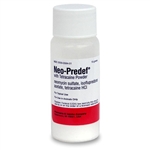


Neo-Predef with Tetracaine Powder is used in the treatment or as an adunct to therapy of ear and skin disorders in dogs, cats and horses caused by neomycin-susceptible organisms and/or allergy. Neo-Predef is also used for minor cuts, wounds, lacerations, abrasions, and for post-surgical application where reduction of pain and inflammatory response is desirable. NEO-PREDEF with Tetracaine Powder may be used as a dusting powder following amputation of tails, claws, and dew-claws, and following ear crops, castrations and spays.
Applied superficially, it has been used successfully in the treatment of acute otitis externa in dogs, acute moist dermatitis and interdigital dermatitis in the dog, and as a dusting powder to various minor cuts, lacerations, and abrasions in the horse, cat and dog.
Neo-Predef with Tetracaine Powder contains in each gram neomycin sulfate, 5 mg (equivalent to 3.5 mg neomycin); isoflupredone acetate, 1 mg; tetracaine hydrochloride, 5 mg; myristyl-gamma-picolinium chloride, 0.2 mg; also lactose hydrous. Because of the prompt, potent, and specific actions of the individual components, this combination is well suited for the treatment of certain ear and skin conditions occurring in dogs, cats and horses.
Advantages of Neo-Predef with Tetracaine
ISOFLUPREDONE ACETATE
Isoflupredone acetate markedly inhibits inflammatory reaction through its controlling influence on connective tissue and vascular components. Topically applied isoflupredone acetate is usually rapidly effective. In otitis externa, wounds of the concha, ulcerations of the ear flaps, and irritated lesions of the skin, the inflammatory response may also be effectively inhibited by isoflupredone acetate. Chronic conditions respond more slowly and relapses are more frequent.
NEOMYCIN
Neomycin is an antibiotic substance derived from cultures of the soil organism Streptomyces fradiae. Its antimicrobial range includes both gram-positive and gram-negative organisms commonly responsible for or associated with otic infections, such as staphylococci, streptococci, Escherichia coli, Aerobacter aerogenes, and many strains of Proteus and Pseudomonas organisms. It is not active against fungi. Neomycin is unusually nontoxic for epithelial cells in tissue culture and is nonirritating in therapeutic concentrations. The presence of neomycin in NEO-PREDEF with Tetracaine Powder affords control of neomycin-sensitive organisms.
TETRACAINE
Tetracaine hydrochloride is a topical anesthetic agent that is more potent than either procaine or cocaine in comparable concentration. The duration of anesthetic action of tetracaine exceeds that produced by either butacaine or phenacaine.
Many investigators have demonstrated that local anesthesia plays a significant part in the promotion of healing, especially where pain is a prominent factor. It is believed that trauma stimulates local pain receptors, which results in reflex vasodilation, edema, tenderness, and muscular spasm.
If the reflex is abolished through use of a local anesthetic such as tetracaine, amelioration of these tissue changes that interfere with healing is favored. The local anesthetic action of tetracaine has proved to be of great value in alleviating the pain reflex in painful skin and ear conditions.
MYRISTYL-GAMMA-PICOLINIUM CHLORIDE
Myristyl-gamma-picolinium Chloride is highly germicidal, nonirritating and relatively nontoxic. In solution it reduces surface tension (a surfactant), possesses detergent and emulsifying actions, and exhibits properties which favor the penetration and wetting of tissue surfaces. The drug is effective against a wide range of organisms, its active ingredient killing in ten minutes Staphylococcus aureus in dilutions up to 1:85,000 at 37 degrees Centigrade; E. typhosa in dilutions up to 1:140,000; Esch. coli in dilutions up to 1:40,000, and S. dysenteriae in dilutions up to 1:80,000.
Myristyl-gamma-picolinium Chloride has been used, per se, for preoperative disinfection of the skin, for application to superficial injuries, for irrigating deep wounds, and for application to infections and wounds of mucous membranes.
CAUTION
Before instilling any medication into the ear, examine the external ear canal thoroughly to be certain the tympanic membrane is not ruptured in order to avoid the possibility of transmitting infection to the middle ear as well as damaging the cochlea or vestibular apparatus from prolonged contact. If hearing or vestibular dysfunction is noted during the course of treatment discontinue use of NEO-PREDEF with Tetracaine Powder.
PRECAUTIONS
Incomplete response or exacerbation of corticosteroid-response lesions may be due to the presence of non-susceptible organisms or to prolonged use of antibiotic-containing preparations resulting in overgrowth of non-susceptible organisms, particularly Monilia. Thus, if improvement is not noted within two or three days, or if redness, irritation, or swelling persists or increases, the diagnosis should be redetermined and appropriate therapeutic measures initiated.
APPLICATION
After cleansing the affected area, NEO-PREDEF with Tetracaine Powder is applied by compressing the sides of the container with short, sharp squeezes. In most instances a single daily application will be sufficient; however, it may be applied one to three times daily, as required.
HOW SUPPLIED
NEO-PREDEF with Tetracaine Powder is available in 15 gram plastic insufflator bottles. Because of the hygroscopic properties of neomycin sulfate, this bottle should be stored in a dry place. The cap should be replaced when the bottle is not in use. The puffer bottle has been designed to permit dusting when held in any position. Protecting the outlet from moisture will aid in assuring proper function; therefore, the tip should not be allowed to come in contact with moist membranes or weeping surfaces.
Additional information not available for this medicine.